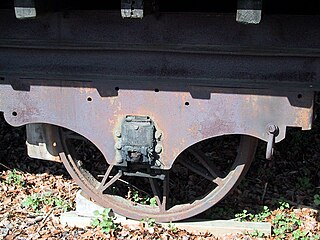
A bogie or railroad truck holds the wheel sets of a rail vehicle.
Axlebox
[edit]An axlebox, also known as a journal box in North America, is the mechanical subassembly on each end of the axles under a railway wagon, coach or locomotive; it contains bearings and thus transfers the wagon, coach or locomotive weight to the wheels and rails; the bearing design is typically oil-bathed plain bearings on older rolling stock, or roller bearings on newer rolling stock.[1]
Plain bearings are now illegal for interchange service in North America.[2][3][4] As early as 1908 axle boxes contained a set of long cylindrical rollers allowing the axle to rotate.[5][6] It was also used on steam locomotives such as the Victorian Railways A2 class, the LMS Garratt, the LSWR 415 class, and the GCR Class 1.[5][dubious – discuss]
Center pin
[edit]A large steel pin—or rod—which passes through the center plates on the body bolster and truck bolster.[7] The truck turns about the pin, and stress is taken by the center plates.[7]
Center plate
[edit]One of a pair of plates which fit one into the other and support the car body on the trucks allowing them to turn freely under the car.[7] The one on the truck may also be called center bowl.[8]
Truck side frame
[edit]The frame at either side of the truck.[3][4]
Truck bolster
[edit]Each truck has a bolster—a transverse floating beam—between the side frames.[9] It is the central part of every truck on which the underframe of the railcar or railroad car is pivoted through the center pivot pin.[7][9]
Side bearing
[edit]There is one side bearing located on each side of the centerplate on the truck bolster. In case of a shared bogie on an articulated car, there are two on each side.
Brake rigging
[edit]The brake rigging includes the brake lever, the brake hanger, the brake pin, the brake beam and the brake shoes.
Image gallery
[edit]- Journal boxes and axle boxes
-
An American journal box showing a plain bearing[10]
-
This Bettendorf-style freight car truck uses journal bearings in journal boxes that are integral parts of the side frames. The center pin can be seen pointing up from the bolster. It has coil springs.
-
An archbar-type truck with American style journal boxes that are bolted to ends of the side frame
-
Japanese archbar truck with axleboxes at the wheels
-
Diamond frame bogie, elliptical springs and American style journal boxes
-
Closeup of a shared bogie with 4 specially adapted side bearings and an articulated connector between two sections of an articulated well car. The roller bearings are not enclosed by an axle box.
See also
[edit]- Axle track
- Ball bearings, or roller bearings, replaced journal bearings for interchange
- Glossary of North American railway terms
- Glossary of rail transport terms
- ICF Bogie
- Roller bearings, replaced journal bearings for interchange
- Rotation around a fixed axis
- Stuffing box
- Timmis system, an early form of coil spring used on railway axles.
- Train wheel
- Wheelbase
- Wheelset
References
[edit]- ^ "Railroad Dictionary: J". CSX.com. CSX Corporation. 2012. Archived from the original on 29 July 2014. Retrieved 15 November 2014.
- ^ Car and Locomotive Cyclopedia 1969
- ^ a b "AAR M-1003 Certified Truck Component Manufacturing". Columbus Castings. Columbus, Ohio. Archived from the original on 12 November 2014. Retrieved 19 November 2014.
- ^ a b "General Information" (PDF). Standard Car Truck Company. January 2000. Archived from the original (PDF) on 4 March 2016. Retrieved 19 November 2014.
- ^ a b "The Evolution of Railway Axlebox Technology". Evolution. SKF. 7 December 2010. Retrieved 18 September 2014.
- ^ "Glossary: A". Railway-Technical.com. Railway Technical Web Pages. 2014. Archived from the original on 7 October 2014. Retrieved 19 November 2014.
- ^ a b c d "Railroad Dictionary: C". CSX.com. CSX Corporation. 2012. Archived from the original on 1 April 2015. Retrieved 15 November 2014.
- ^ "APTA PR-CS-RP-003-98 Recommended Practice for Developing a Clearance Diagram for Passenger Equipment" (PDF). APTA.com. American Public Transportation Association. 26 March 1998. Archived from the original (PDF) on 26 June 2015. Retrieved 17 January 2015.
- ^ a b "Railroad Dictionary: B". CSX.com. CSX Corporation. 2012. Archived from the original on 29 July 2014. Retrieved 15 November 2014.
- ^ CSX Dictionary J Archived 2014-07-29 at the Wayback Machine
Further reading
[edit]- US Army Field Manual FM 55-20, Figure 8-8, Department of the Army, Washington DC
- Car and Locomotive Cyclopedia 1970
- Forney, Matthias N. (1879). The Railroad Car Builder's Dictionary. Dover Publications.
- White, John H. (1978). The American Railroad Passenger Car. Baltimore, MD: Johns Hopkins University Press. ISBN 0801819652. OCLC 2798188.
- White, John H. Jr. (1993). The American Railroad Freight Car: From the Wood-Car Era to the Coming of Steel. Baltimore: Johns Hopkins University Press. ISBN 0-8018-4404-5. OCLC 26130632.
![An American journal box showing a plain bearing[10]](Https://upload.wikimedia.org/wikipedia/commons/thumb/0/0e/Journal_box.png/155px-Journal_box.png)








Well, that’s interesting to know that Psilotum nudum are known as whisk ferns. Psilotum nudum is the commoner species of the two. While the P. flaccidum is a rare species and is found in the tropical islands. Both the species are usually epiphytic in habit and grow upon tree ferns. These species may also be terrestrial and grow in humus or in the crevices of the rocks.
View the detailed Guide of Psilotum nudum: Detailed Study Of Psilotum Nudum (Whisk Fern), Classification, Anatomy, Reproduction